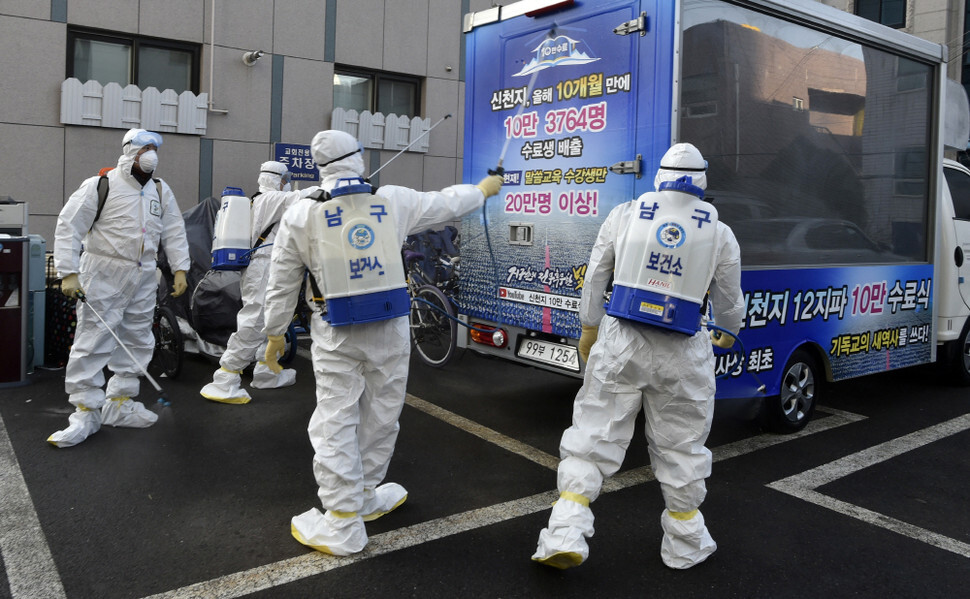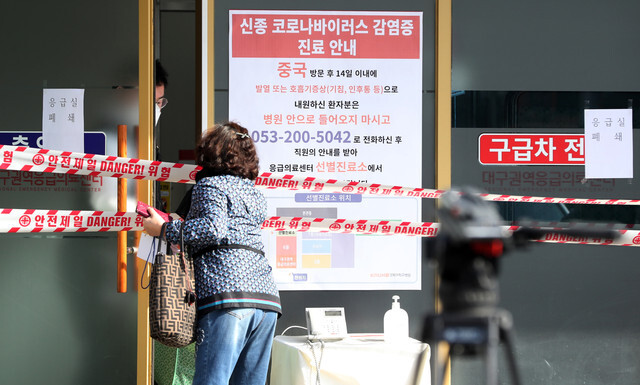hankyoreh
Links to other country sites 다른 나라 사이트 링크
S. Korea confirms 22 new coronavirus cases in a single day

The number of confirmed cases of the novel coronavirus in South Korea jumped by 22 in recent days after the first transmission cluster occurred at the local level. Twenty of the cases were in Daegu and North Gyeongsang Province alone, representing the first instance of a “super spreader.” The public health authorities regard this transmission cluster as being localized for now as they continue their epidemiological survey. Experts say that community transmission occurred faster than expected.
Figures released by South Korea Centers for Disease Control and Prevention (KCDC) show that 22 new cases of COVID-19, the disease caused by the coronavirus, were confirmed on Wednesday alone. This brings the total number of confirmed cases in the country to 53. Fourteen of the 20 new patients in Daegu and North Gyeongsang Province were confirmed to be attending the same church as the 31st patient, a Daegu branch of the Shincheonji religious movement. One of the others was an employee of the Saeronan Traditional Medicine Hospital (in Daegu’s Suseong District), where the 31st patient was hospitalized; the authorities are still tracing the routes of transmission for the other three. The 31st patient, who had tested positive the previous day, is a 61-year-old South Korean woman living in Daegu. She’d attended church four times both before and after coming down with the disease and was admitted to Saeronan Traditional Medicine Hospital on Feb. 7.
Confirmed instance of a “super spreader”
“Since the 31st patient and 14 of the additional cases are all connected with a specific church, we’re regarding this as an instance of a super spreader,” said KCDC Director Jung Eun-kyeong.
In addition to the cluster of infections in Daegu and North Gyeongsang Province, a man in his 70s in Seoul’s Seongdong District tested positive for the disease on Wednesday, even though he hasn’t traveled abroad recently. The country also saw its first case of a child contracting the disease. While the 20th patient was under self-quarantine, his daughter exhibited symptoms and tested positive for the virus.
Despite the big bump in confirmed cases yesterday, the government doesn’t regard this as a national epidemic and has maintained the alert status at the current level of “orange,” the third of four levels. The authorities say that, if the new disease is transmitted locally or spreads around the country, they will raise the alert to the highest level of “red.”
“We still don’t think there’s a risk [of COVID-19] becoming a national epidemic, and we regard these as localized small-scale transmission clusters,” Jung said.

Experts are saying that the disease should be regarded as spreading locally and appropriate action taken in response. “Local transmission has struck sooner than expected,” said Lee Jae-gap, a professor of infectious disease at Hallym University.
This is leading experts to call for prompt action so that infected patients can be identified and treated at the onset of the disease. “We have to regard this as local transmission. If the disease spreads to patients with chronic conditions when they visit hospitals, things will get ugly,” said Choe Won-seok, a professor of infectious disease at Korea University Ansan Hospital.
The government intends to devote all its energy to preventing further spread of COVID-19 in the community. Responding to the confirmation of multiple cases of the disease in Daegu and North Gyeongsang Province on Thursday, South Korean President Moon Jae-in called for “setting up a sure defense by massively strengthening our system for responding to local transmission.”
16 patients have made full recovery
When the newly revised COVID-19 response guidelines (the sixth edition) go into effect on Feb. 20, the public health authorities intend to greatly expand eligibility for testing. Medical personnel will be allowed to test suspected individuals at their discretion, even if they haven’t traveled overseas. Patients who are admitted to the hospital with inexplicable cases of pneumonia will be tested for the coronavirus in a negative pressure room or a private room.
In related news, four COVID-19 patients in South Korea (the sixth, 10th, 16th, and 18th) were discharged from hospitals on Wednesday after their symptoms improved and they tested negative two times in a row. So far, 16 patients have made a full recovery and been released from quarantine.
By Park Da-hae and Seong Yeon-cheol, staff reporters
Please direct comments or questions to [english@hani.co.kr]

Editorial・opinion
![[Column] Samsung’s ‘lost decade’ and Lee Jae-yong’s mismatched chopsticks [Column] Samsung’s ‘lost decade’ and Lee Jae-yong’s mismatched chopsticks](https://flexible.img.hani.co.kr/flexible/normal/500/300/imgdb/original/2024/0512/3017154788490114.jpg) [Column] Samsung’s ‘lost decade’ and Lee Jae-yong’s mismatched chopsticks
[Column] Samsung’s ‘lost decade’ and Lee Jae-yong’s mismatched chopsticks![[Correspondent’s column] The real reason the US is worried about Chinese ‘overcapacity’ [Correspondent’s column] The real reason the US is worried about Chinese ‘overcapacity’](https://flexible.img.hani.co.kr/flexible/normal/500/300/imgdb/original/2024/0510/5217153290112576.jpg) [Correspondent’s column] The real reason the US is worried about Chinese ‘overcapacity’
[Correspondent’s column] The real reason the US is worried about Chinese ‘overcapacity’- [Editorial] Yoon’s gesture at communication only highlights his reluctance to change
- [Editorial] Perilous stakes of Trump’s rhetoric around US troop pullout from Korea
- [Guest essay] Preventing Korean Peninsula from becoming front line of new cold war
- [Column] The state is back — but is it in business?
- [Column] Life on our Trisolaris
- [Editorial] Penalties for airing allegations against Korea’s first lady endanger free press
- [Editorial] Yoon must halt procurement of SM-3 interceptor missiles
- [Guest essay] Maybe Korea’s rapid population decline is an opportunity, not a crisis
Most viewed articles
- 1Seoul’s plan to adopt SM-3 missiles is like wanting a sledgehammer to catch a fly
- 2[Column] Samsung’s ‘lost decade’ and Lee Jae-yong’s mismatched chopsticks
- 3‘We must say no’: Seoul defense chief on Korean, USFK involvement in hypothetical Taiwan crisis
- 4[Correspondent’s column] The real reason the US is worried about Chinese ‘overcapacity’
- 5S. Korea “monitoring developments” after report of secret Chinese police station in Seoul
- 6Yoon voices ‘trust’ in Japanese counterpart, says alliance with US won’t change
- 7Yoon rejects calls for special counsel probes into Marine’s death, first lady in long-awaited presse
- 846% of cases of violence against women in Korea perpetrated by intimate partner, study finds
- 9N. Korean delegation’s trip to Iran shows how Pyongyang is leveraging ties with Moscow
- 10Korea poised to overtake Taiwan as world’s No. 2 chip producer by 2032